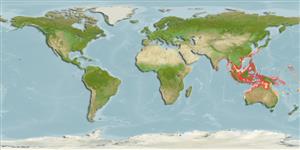Classification / Names
ชื่อสามัญ | ชื่อพ้อง | Catalog of Fishes(สกุล, ชนิด) | ITIS | CoL | WoRMS | Cloffa
sub class Elasmobranchii (ฉลามและกระเบน) (sharks and rays) >
Myliobatiformes (Stingrays) >
Dasyatidae (Stingrays) > Urogymninae
Etymology: More on author: Gray.
Environment: milieu / climate zone / depth range / distribution range
นิเวศวิทยา
เกี่ยวกับทะเล,น้ำเค็ม; กร่อย สัตว์น้ำหน้าดิน; ระดับความลึก ? - 50 m (Ref. 5578). Tropical
Indo-West Pacific: Oman to Indonesia; north to Taiwan.
Length at first maturity / ขนาด / น้ำหนัก / Age
Maturity: Lm ?, range 64 - ? cm
Max length : 200 cm TL เพศผู้/กระเทย; (Ref. 9840)
Likely confined to the inner continental shelf (Ref. 9840), over sandy and mud bottoms (Ref. 30573). Recorded from coastal waters and river mouths (Ref. 45255). Feeds on bottom crustaceans including shrimp, crabs and small lobsters (Ref. 5578). Ovoviviparous (Ref. 50449). Important food fish, the skin and flesh are dried or used to produce leather for purses and bags (Ref. 9840). Caught in very large quantities in the demersal tangle net, bottom trawl and trammel net fisheries. Utilized for its meat, skin (high value) and cartilage (Ref. 58048). It is parasitised on the dorsal skin surface by the monogeneans Dendromonocotyle citrosa, D. colorni, D. ukuthena (Ref. 124058) and D. lotteri (Ref. 124051).
Exhibit ovoviparity (aplacental viviparity), with embryos feeding initially on yolk, then receiving additional nourishment from the mother by indirect absorption of uterine fluid enriched with mucus, fat or protein through specialised structures (Ref. 50449). Distinct pairing with embrace (Ref. 205). Bears 2 young in summer (Ref. 5578). Gives birth to litters of 1-4 pups; born at 18-21 cm WD (Ref.58048).
Last, P.R., W.T. White, M.R. de Carvalho, B. Séret, M.F.W. Stehmann and G.J.P. Naylor, 2016. Rays of the world. CSIRO Publishing, Comstock Publishing Associates. i-ix + 1-790. (Ref. 114953)
IUCN Red List Status (Ref. 130435)
Threat to humans
Harmless
Human uses
การประมง: การค้า; การตกปลาเป็นกีฬา: ใช่; สถานที่แสดงสัตว์และพืชน้ำ: การค้า
ข้อมูลเพิ่มเติม
อ้างอิงการเพาะเลี้ยงสัตว์น้ำประวัติการเพาะเลี้ยงสัตว์น้ำสายพันธุ์พันธุศาสตร์ElectrophoresesอัตราพันธุกรรมโรคการแปรรูปNutrientsMass conversion
ผู้ร่วมมือรูปภาพหลายรูปStamps, Coins Misc.เสียงปลามีพิษ เช่น ปลาปักเป้าความเร็วรูปแบบการว่ายน้ำพื้นที่เหงือกOtolithsสมองวิสัยทัศน์
เครื่องมือ
Special reports
Download XML
แหล่งที่มาจากอินเตอร์เน็ต
Estimates based on models
Preferred temperature (Ref.
123201): 24.7 - 29.1, mean 28.4 °C (based on 1116 cells).
Phylogenetic diversity index (Ref.
82804): PD
50 = 0.5078 [Uniqueness, from 0.5 = low to 2.0 = high].
Bayesian length-weight: a=0.01622 (0.00606 - 0.04338), b=3.00 (2.77 - 3.23), in cm total length, based on LWR estimates for this (Sub)family-body shape (Ref.
93245).
ระดับชั้นอาหาร (Ref.
69278): 3.7 ±0.55 se; based on food items.
ความสามารถในการกลับคืนสู่ปกติ (Ref.
120179): ต่ำมาก, เวลาต่ำสุดที่จะทำให้ประชากรเพิ่มขึ้นเป็น 2 เท่าใช้เวลามากกว่า 14 ปี (Fec=2).
Fishing Vulnerability (Ref.
59153): Very high vulnerability (90 of 100).
Climate Vulnerability (Ref.
125649): Moderate to high vulnerability (50 of 100).
Nutrients (Ref.
124155): Calcium = 12.9 [1.9, 252.0] mg/100g; Iron = 0.63 [0.06, 7.40] mg/100g; Protein = 20.9 [18.3, 23.5] %; Omega3 = 0.122 [0.038, 0.345] g/100g; Selenium = 50.3 [10.3, 257.1] μg/100g; VitaminA = 4.98 [0.44, 49.87] μg/100g; Zinc = 0.725 [0.044, 8.176] mg/100g (wet weight);
